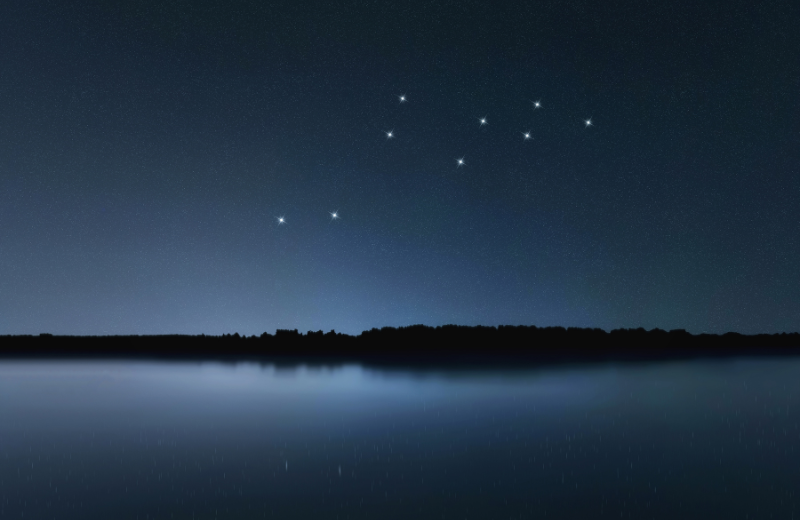The Lacerta constellation, also known as the “Lizard constellation,” is a lesser-known but fascinating feature of the night sky. Its intriguing shape, mythological backstory, and notable stars make it an excellent choice for exploration. This guide shares everything you need to know about Lacerta, from its unique features and historical background to tips for finding it in the sky.
Jump to:
Recommended for you!
Best SellersWhat is the Lacerta Constellation?
Lacerta is a small but striking constellation in the northern hemisphere. Its name, Latin for "lizard," reflects its slender, zigzagging shape, which some say resembles a reptile crawling across the heavens. Located in a rich region of the Milky Way, Lacerta lies between the constellations of Cygnus, Andromeda, and Pegasus.
The constellation was officially introduced in 1687 by Polish astronomer Johannes Hevelius, who included it in his catalogue of stars. Lacerta is one of the newer constellations, created during a time when astronomers sought to name previously undefined regions of the sky.
What Does Lacerta Look Like?

Lacerta’s distinct zigzag pattern makes it relatively easy to identify, despite its smaller size. The constellation is composed of faint stars, the brightest of which only reaches a magnitude of 3.76. Its stars form a narrow, crooked line resembling a lizard's body. Observers often compare its shape to a lightning bolt or the outline of the reptile it’s named after.
The constellation is located in a dense area of the Milky Way, making it a fascinating region to explore with binoculars or a telescope. Alongside its stars, you can spot various deep-sky objects, including clusters and nebulae.
How Far is the Lacerta Constellation from Earth?
Since Lacerta is not a single celestial object but a collection of stars, its distance varies depending on which star you observe. One of its most notable stars, Alpha Lacertae, is approximately 102 light-years away. The other stars in the constellation range from tens to hundreds of light-years, creating a patchwork of distant suns.
The Lacerta Constellation Myth
Unlike many constellations with roots in ancient Greek or Roman mythology, Lacerta doesn’t have a mythological tale tied to its origins. Instead, its name and shape reflect a more modern approach to constellation naming. Johannes Hevelius chose the lizard motif to fill an empty space in the celestial charts, inspired by its reptilian appearance.
Although Lacerta lacks a myth of its own, it lies near other constellations steeped in legend, such as Cygnus the Swan and Pegasus the Winged Horse, making it an excellent addition to a stargazer’s mythological map of the night sky.
Lacerta's Stars

Lacerta, while modest in size, features a captivating collection of stars with unique traits:
- Alpha Lacertae: As the brightest star in Lacerta, Alpha Lacertae is a dazzling blue-white giant located approximately 102 light-years from Earth. Its luminosity and crisp colour make it a highlight within this subtle constellation.
- Beta Lacertae: Following closely in prominence, Beta Lacertae is slightly dimmer but still commands attention as a key feature in Lacerta's starry composition.
- 1 Lacertae: This intriguing binary star system, situated further out, can be resolved with a telescope, offering a rewarding challenge for stargazers.
- Variable Stars: Lacerta also includes R Lacertae, a variable star whose brightness fluctuates over time, adding dynamic interest to this compact constellation.
Nebulae in the Lacerta Constellation

Lacerta lies in a dense part of the Milky Way, making it rich in nebulae and other deep-sky objects. Notably, it is home to the famous BL Lacertae object, a type of galaxy nucleus known as a blazar. This fascinating object is a source of high-energy gamma rays and provides a unique opportunity for astronomers studying active galaxies.
While Lacerta lacks Messier objects, its position makes it a treasure trove for observers interested in exploring star clusters and faint nebulae.
Finding Lacerta in the Sky
Lacerta can be found in the northern sky, nestled between the more prominent constellations of Cygnus and Andromeda. To locate it, start by finding the easily recognisable W-shaped constellation of Cassiopeia, then look slightly southward. Using a star map or an astronomy app can also help pinpoint its exact location.
The best time to view Lacerta is during the autumn months when it is high in the sky during the evening hours. From the UK, Lacerta is visible throughout most of the year due to its northern position, but it appears brightest and clearest in autumn.
Recommended for you!
Best SellersFun Facts About Lacerta
- Reptilian Roots: Lacerta is one of the few constellations named after a reptile, making it stand out among celestial groupings. Its name, derived from the Latin word "lacerta," meaning "lizard," perfectly captures its scaly inspiration.
- Astronomical Rarity: Lacerta hosts the BL Lacertae object, a rare blazar that has fascinated scientists for decades. This active galactic nucleus provides valuable insights into high-energy processes in the universe.
- Hidden Gem: Although small and faint, Lacerta is located in a dense region of the Milky Way, offering a rewarding observation experience for those who take the time to explore its unique features.
Study Astronomy for £29
If the Lacerta constellation has sparked your curiosity, why not explore more about the stars and the cosmos with our Astronomy Diploma Course at Centre of Excellence? This course offers a detailed understanding of the universe, from constellations and star types to the fundamentals of space observation. Perfect for all budding astronomers, the course is available for a discounted price of £29.













